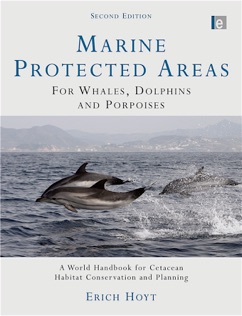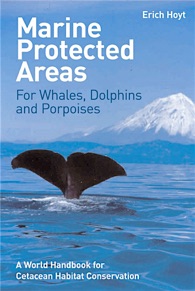Marine Protected Areas for Whales, Dolphins and Porpoises

Published Sept 2011 by Earthscan, London and New York, in association with WDC, Whale and Dolphin Conservation.
Fully revised 2nd edition, 477 pages, 20 colour plates, 100+ maps, figures, tables & boxes, 10 case studies, bibliog., index, Quarto: 11" x 8 3/4" (22 × 28 cm). Paperback £39.99 /$69.95. Simultaneous hardcover edition, £95 / $160.00.
A few copies are still available at discount from ErichHoytBooks.com (2017).
The influential journal CHOICE in the US has selected Marine Protected Areas for Whales, Dolphins and Porpoises as one of the Outstanding Academic books of 2012 (Choice, Feb 2013 issue) declaring this book is “a critical reference for anyone entering the debate about cetacean conservation or seeking to promote marine protected areas for cetaceans. Summing Up: Essential. All academic, general, and professional audiences.” — Choice
“A key question asked by publishers when a second edition of a book is up for discussion is whether buyers of the first edition will feel compelled to purchase the second. In this case the answer must be yes: much has been learned in the past few years, many new MPAs installed. For example, numerous MPAs and sanctuaries originally listed as ‘proposed’ are now ‘established’, and many previously unmentioned areas are now under discussion or on the ‘possible candidates’ list. Comparing the two editions on a page-by-page basis is nearly impossible – the shifts and changes are too great. In a word, the old edition simply won’t do. Statistically, the new edition has significantly more figures, tables and boxes. The number and quality of the color plates has also been improved considerably. This extraordinary volume continues to be the ‘bible’ of cetacean habitat conservation efforts and deserves its ‘world handbook’ subtitle.” — Michael Stachowitsch, Marine Ecology (2012)
“Essential reading as the protected area system around the world rapidly expands. Planning and managing for the wellbeing of marine mammals is essential for all protected area managers.”
— Carl Gustaf Lundin, Head, IUCN Global Marine and Polar Programme
“The world’s oceans face numerous threats and there is strong scientific consensus that marine protected areas are a key solution. This book is a valuable contribution to understanding the successes, opportunities and challenges we face as we strive to conserve the oceans, the creatures that live in them and the important role they play in supporting human health, food and economies.” – David Suzuki
“ Erich Hoyt, a renowned conservationist, exhibits a strong passion for research and writing which is evident in his publication of 18 books and over 500 articles, reports, and book chapters. From the North American Midwest to a Victorian seaside town in Scotland, Hoyt has led a full suite of conservation projects and has established himself as a lead proponent of sustainable ecotourism, habitat protection, and ecosystem-based management for marine mammals. His plethora of writing samples has been used as reference guides for marine mammal researchers, conservationists, and enthusiasts throughout the world. Time and again, he has succeeded in conducting comprehensive reviews and summarizing a wealth of information in a user-friendly and engaging format. His latest book, an update to the first edition about marine protected areas for whales, dolphins, and porpoises (Hoyt, 2005), is no exception....I strongly support this book as an invaluable addition to the library of any marine mammal manager and conservationist as well as regulators, industry leaders, and decisionmakers. This book was clearly written for a scientific/technical audience and not necessarily for the layperson due to the technical nature of the content and the lack of personal stories, anecdotes, and more photos and attractive illustrations. Hoyt writes with an underlying sense of urgency but also with hope and a plan that can be put into action. Fortunately, the reader is not left with an overwhelming feeling of despair over the long road ahead for cetacean MPAs and the immense amount of work left for researchers, managers, and stakeholders to effectively protect cetacean habitat. Instead, we are left with a better understanding of where we currently stand, where we need to go, and how to go about it. Hoyt has given us an MPA roadmap complete with specific tools and checklists to help us along the way. — Amy D. Whitt, Aquatic Mammals 2012, 38(2), 224-226, DOI 10.1578/AM.38.2.2012.224
© 2019 Erich Hoyt. All rights reserved.


